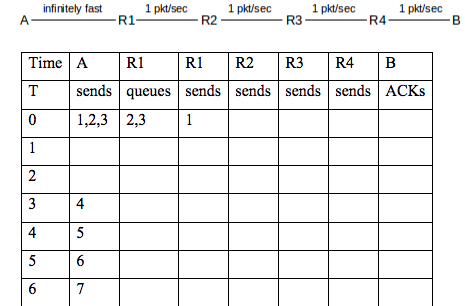Question
Assume the following network scenario. Flow BA direction, all transmissions are infinitely fast, i.e. zero delay; this is often a good approximation because ACK packets
Assume the following network scenario. Flow BA direction, all transmissions are infinitely fast, i.e. zero delay; this is often a good approximation because ACK packets are what travel in that direction and they are negligibly small. In the AB direction, we will assume that the AR1 link is infinitely fast, but the other four each have a bandwidth of 1 packet/second (and no propagation-delay component). This makes the R1R2 link the bottleneck link; any queue will now form at R1. The path bandwidth is 1 packet/second, and the RTT is 4 seconds. Questions: provided a winsize=3, complete the following table whenever there is a packet available.

Note: the brief pile-up at R1 (the bottleneck link!) on startup. However, in the steady state, there is no queuing. i.e At T=3, R1 has just finished sending Data[3] as Data[4] arrives from A; R1 can begin sending packet 4 immediately. No queue will develop. Real sliding-windows protocols generally have some way of minimizing this initial pileup.
1 pkt/sec 1 pkt/sec 1 pkt/sec 1 pkt/sec R1 R2 R3 R4 R1 Time | A T sends queues sends sends sends sends |ACKs 0 1,2,3 2,3 1 4 45Step by Step Solution
There are 3 Steps involved in it
Step: 1

Get Instant Access to Expert-Tailored Solutions
See step-by-step solutions with expert insights and AI powered tools for academic success
Step: 2

Step: 3

Ace Your Homework with AI
Get the answers you need in no time with our AI-driven, step-by-step assistance
Get Started


